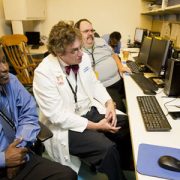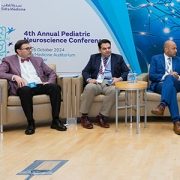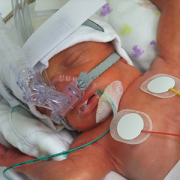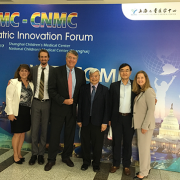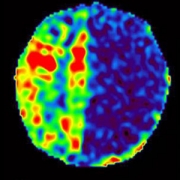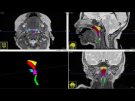Putting childhood epilepsy in the spotlight at American Epilepsy Society Meeting
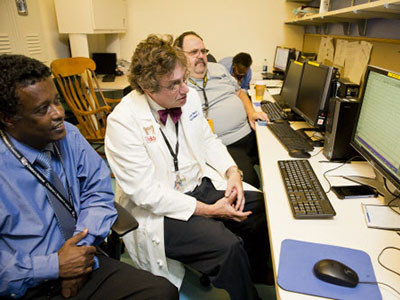
“We aim to build the evidence base for treatments that are effective specifically for children with epilepsy,” says William D. Gaillard, M.D., chief of Child Neurology, Epilepsy and Neurophysiology, and director of the Comprehensive Pediatric Epilepsy Program.
While epilepsy affects people of all ages, the unique way it manifests in infants, children and adolescents can be attributed in part to the complexities of the growing and developing brain. Researchers from the Children’s National Comprehensive Pediatric Epilepsy Program brought their expertise on the challenges of understanding and treating epilepsy in children to the recent American Epilepsy Society Annual Meeting, the largest professional gathering on epilepsy in the world.
“We aim to build the evidence base for treatments that are effective specifically for children with epilepsy,” says William D. Gaillard, M.D., chief of Child Neurology, Epilepsy and Neurophysiology, and director of the Comprehensive Pediatric Epilepsy Program. “We have learned much from studies in adult populations but technologies like functional MRI allow us to get in-depth understanding, often in non-invasive ways, of precisely how epilepsy is impacting a child.”
Dr. Gaillard was also recently elected to serve as the Second Vice President of the American Epilepsy Society. “The AES is the largest multidisciplinary professional and scientific society dedicated to the understanding, treatment and eradication of epilepsy and associated disorders, and I am honored to serve as the new Second Vice President,” he said.
The team’s presentations and poster sessions focused on several key areas in pediatric epilepsy:
Better ways to see, measure and quantify activity and changes in the brain for children with epilepsy before, during and after surgery
- Novel applications of fMRI for children with epilepsy
- Evaluation of an fMRI tool that tracks verbal and visual memory in children with epilepsy – one of the first to capture memory functions in this population of children using noninvasive fMRI;
- Early study of the use of “resting-state” fMRI to map language skills before epilepsy surgery – an important first step toward noninvasively evaluating children who are too young or neurologically impaired to follow tasks in traditional MRI studies;
- A study of whether intraoperative MRI, i.e. imaging during neurosurgery, allows for more complete removal of abnormal brain tissue associated with focal cortical dysplasia in children, which is a common cause of intractable epilepsy;
- A preliminary case review of existing data to see if arterial spin labeling MRI, which measures blood flow to the brain, has potential to identify blood flow changes in specific locations of the brain where seizures occur;
- An analysis of language laterality – the dominant side of the brain controlling language – questioning the true reasons that the brains of children with epilepsy have differences in the hemisphere that predominantly controls language;
- A review of some common assessments of language and working memory that are used pre- and post-operatively to gauge the impacts of pediatric epilepsy surgery. The study found that using multiple assessments, and studying results individually rather than as a group average, resulted in a more complete picture of the outcomes of surgery on these areas of brain function;
- A preliminary study examining whether continuous EEG monitoring of neonates with hypoxic ischemic encephalopathy, or lack of oxygen to the brain, can be a reliable predictor of neurodevelopmental outcomes while the infant is undergoing therapeutic hypothermia.

“In order to expand our understanding of causes, impacts and outcomes, the range of research is broad given the complexity of epilepsy,” says Madison M. Berl, Ph.D. “This is the only way we can contribute to the goal of providing our colleagues and the families they serve with better resources to make informed decisions about how best to assess and treat pediatric epilepsy.”
The molecular, genetic and biological factors that contribute to onset and severity of pediatric epilepsy
- A retrospective study of young patients with malformations in cortical development that are important causes of childhood epilepsy;
- Investigation of a simple saliva test to effectively identify the presence of two common viral infections, human herpesvirus-6B and Epstein-Barr virus, that may be contributors to onset of epilepsy in otherwise normally functioning brains;
- A preliminary review of the possible relationship between febrile infection-related epilepsy syndrome and the co-occurrence of another neuro-inflammatory condition – hemophagocytic lymphohistiocytosis.
Madison Berl, Ph.D., director of research in the Division of Pediatric Neuropsychology, and a pediatric neuropsychologist in the Comprehensive Pediatric Epilepsy Program, adds, “In order to expand our understanding of causes, impacts and outcomes, the range of research is broad given the complexity of epilepsy. This is the only way we can contribute to the goal of providing our colleagues and the families they serve with better resources to make informed decisions about how best to assess and treat pediatric epilepsy.”


